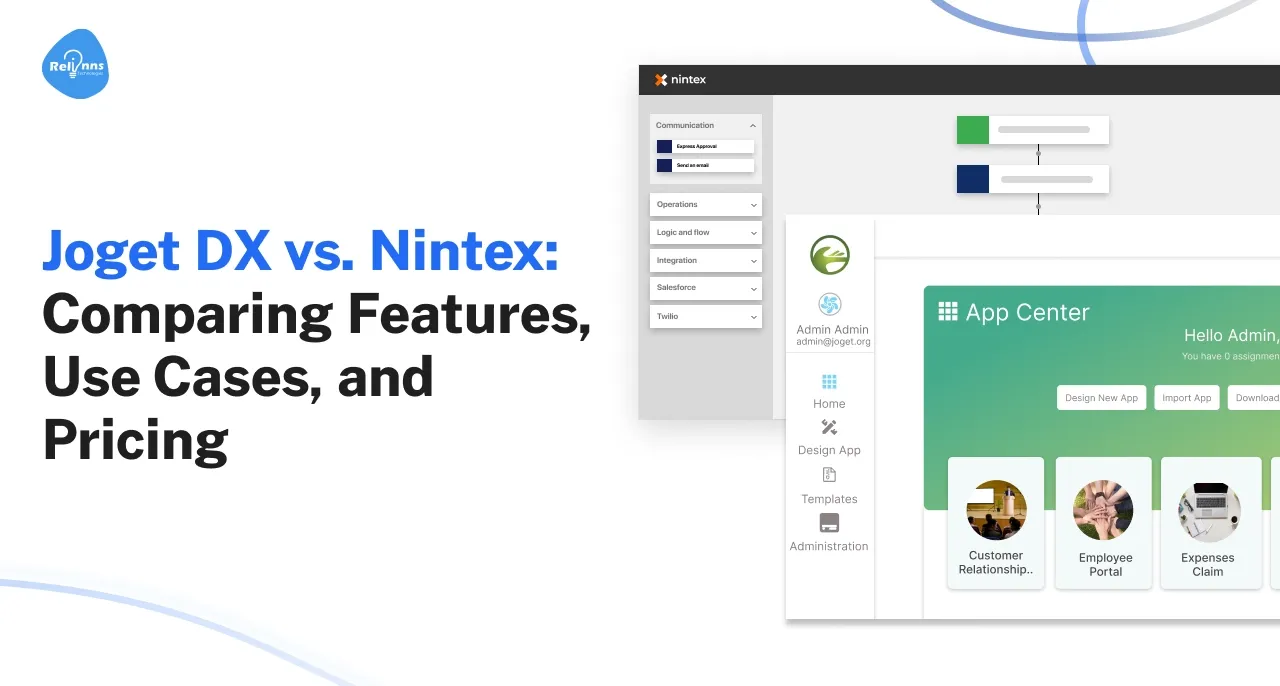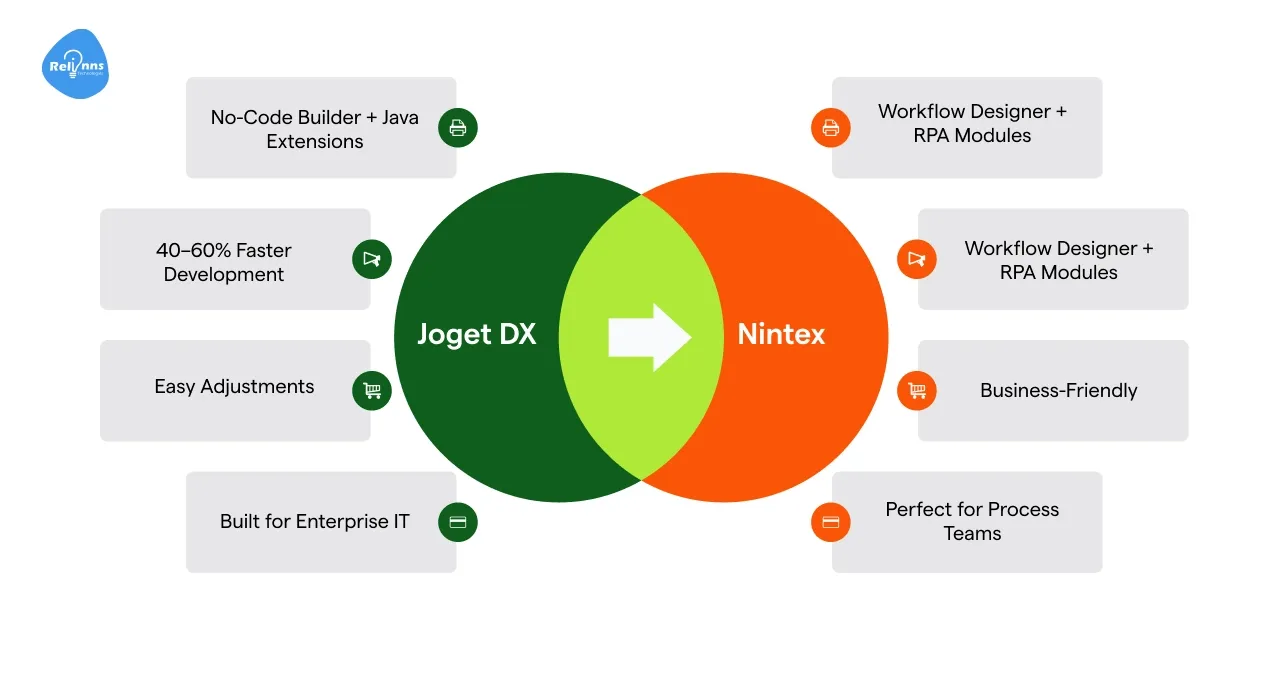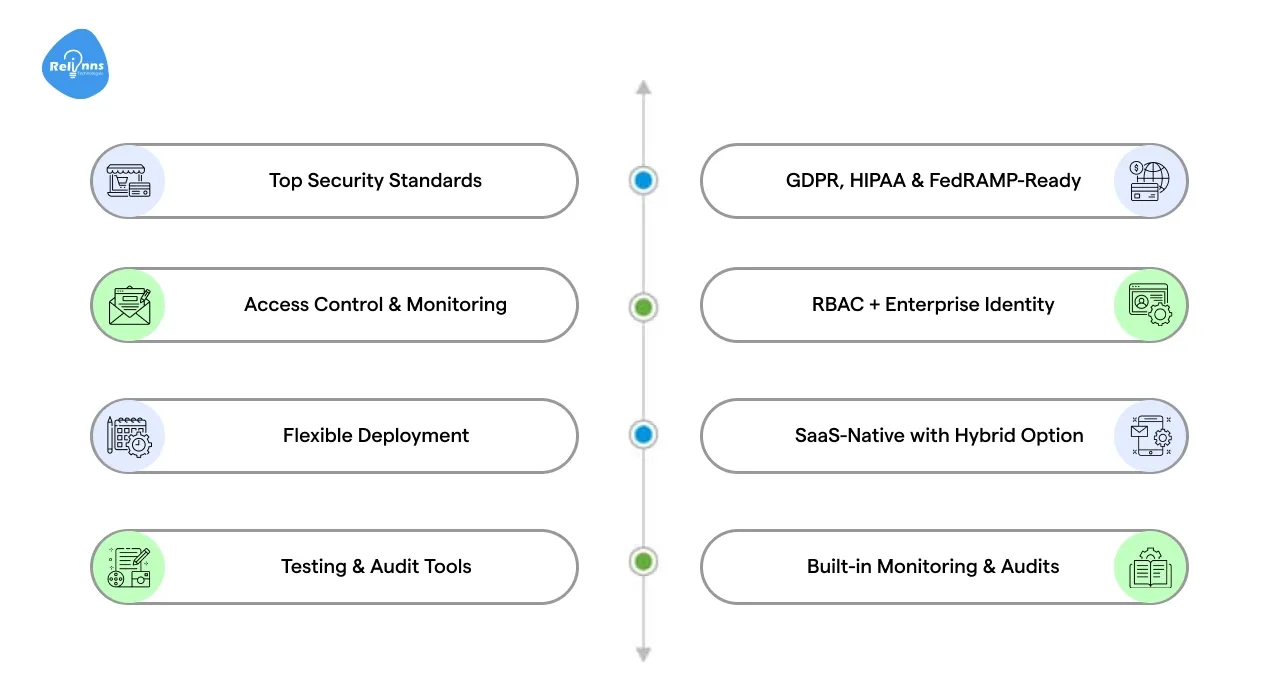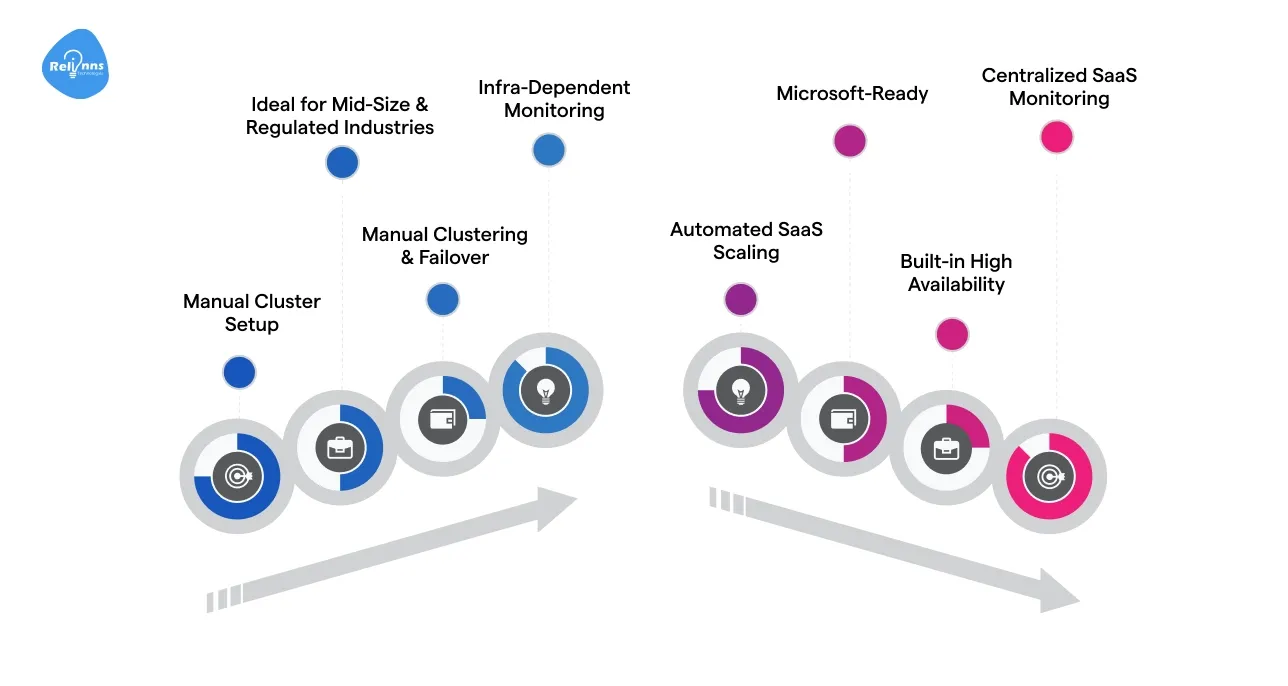Joget DX vs. Nintex: Comparing Features, Use Cases, and Pricing
Date
Sep 15, 25
Reading Time
7 Minutes
Category
Low-Code/No-Code Development

Low-code automation is no longer experimental—it’s how enterprises scale.
IDC reports that companies adopting low-code platforms deliver applications up to 5x faster and cut operational costs by 40%. That’s why the Joget vs Nintex debate matters for CIOs and IT leaders right now.
Both platforms tackle workflow automation, but in different ways. Joget DX emphasizes open-source flexibility, enterprise-grade compliance, and extensibility, making it appealing for teams that need control over infrastructure and customization. To learn more, refer to our comprehensive Joget platform guide.
Nintex, on the other hand, has long been recognized as a workflow powerhouse, known for business process automation, robotic process automation (RPA), and document generation tightly linked to Microsoft and SharePoint environments.
This Nintex vs. Joget DX Comparison will cut through the noise: features, pricing, pros, cons, and real-world use cases—so you know which tool fits your roadmap best.
What is Nintex?
Nintex is a workflow automation and business process management platform widely adopted by enterprises for document generation, RPA, and process orchestration.
Originally tied closely to Microsoft and SharePoint, Nintex has since expanded into a cloud-first, low-code platform with drag-and-drop workflow design.
App Development Features Comparison: Joget DX vs. Nintex
Both Joget DX and Nintex help enterprises automate and accelerate, but their emphasis is different.
Key Differences: Joget vs Nintex
| Feature / Factor | Joget DX Highlights | Nintex Highlights |
| Deployment | Flexible on-premises, cloud, and Kubernetes support | Cloud, hybrid, or on-premises with SaaS-first focus |
| Target Users | Mid-sized enterprises, IT teams, regulated industries | Large enterprises, business teams, Microsoft-heavy users |
| Customization | Java plugins, REST APIs, open-source extensions | Workflow designer, RPA, limited deep-code customization |
| Integration | REST/SOAP APIs, JDBC, custom connectors | Prebuilt connectors for Microsoft 365, Salesforce, SAP, DocuSign |
| Pricing | Free Community Edition; Enterprise from ~$13/user/monthly | Quote-based enterprise licensing, varies by modules (workflow, RPA, e-signature) |
| Scalability | Manual cluster setup, Kubernetes container support | SaaS-based scaling with automated load handling |
| Ecosystem | Smaller, community-driven marketplace | Large enterprise ecosystem, especially Microsoft-centric |
| Compliance | ISO 27001, SOC 2 certified | GDPR, HIPAA, FedRAMP-ready (for government/regulated sectors) |
For teams comparing Nintex vs. Joget DX, the decision often rests on whether you need open extensibility or workflow-first automation with SaaS depth.
Pros and Cons: Joget vs Nintex

Choosing between Joget DX and Nintex means balancing flexibility vs workflow depth. Each platform has distinct advantages and trade-offs depending on your enterprise needs.
Pros and Cons of Joget DX Summary
| Joget DX – Pros (Stat-Based) | Joget DX – Cons |
| Affordable standard licensing (~$5/user/monthly) | Smaller marketplace than SaaS competitors |
| ISO 27001 and SOC 2 compliance | Limited prebuilt SaaS connectors |
| On-premises, cloud, and Kubernetes flexibility | Steeper setup curve for non-technical teams |
| Open-source with Java plugin extensibility | Lacks native RPA/document automation |
| Free Community Edition for trials | Narrower global brand recognition |
Pros and Cons of Nintex Summary
Nintex excels in workflow automation, RPA, and document generation, making it a top choice for Microsoft-heavy enterprises.
| Nintex – Pros (Stat-Based) | Nintex – Cons |
| Native workflow automation at enterprise scale | Higher licensing and module costs |
| Strong Microsoft and SharePoint integrations | Heavy reliance on Microsoft ecosystem |
| Built-in RPA and document automation | Limited deep customization options |
| Compliance-ready: GDPR, HIPAA, FedRAMP | Complex licensing structure |
| Large enterprise adoption across industries | Less flexible for hybrid or open infra setups |
A. Scalability and Performance
Enterprises demand reliable scaling. Joget DX allows manual scaling with Kubernetes or Docker, offering infrastructure control.
Nintex, being SaaS-first, handles scaling automatically but limits customization beyond its managed environment.
| Factor | Joget DX | Nintex |
| Scaling | Manual cluster setup with Docker/Kubernetes | Automated SaaS scaling |
| Footprint | Strong for mid-size and regulated industries | Ideal for Microsoft-heavy enterprises |
| Availability | Manual clustering and failover needed | Built-in high availability |
| Monitoring | Infra-dependent monitoring tools | Centralized SaaS monitoring |
Suggested Reading: Joget DX vs Mendix: A Strategic Enterprise Comparison
B. Integration and Extensibility
Integration is a major differentiator. Joget supports REST/SOAP APIs, JDBC, and custom plugins for deep extensibility.
Nintex shines with prebuilt connectors to Microsoft 365, Salesforce, SAP, and DocuSign.
| Factor | Joget DX | Nintex |
| APIs & Connectors | REST/SOAP APIs, JDBC, plugin support | Prebuilt connectors for Microsoft 365, Salesforce, SAP, DocuSign |
| Extensibility | Open-source, Java plugin extensions | Limited scripting, RPA-driven extensions |
| Data Sources | SQL/NoSQL supported | SaaS-driven, tied to enterprise apps |
| Marketplace | Smaller, community-driven | Large Microsoft-centric ecosystem |
C. Customization and Development Speed

Joget DX enables fast prototyping with extensibility, while Nintex is optimized for workflow automation speed, particularly for business users.
| Factor | Joget DX | Nintex |
| Development Style | No-code builder + Java plugin extensions | Workflow designer + RPA modules |
| Speed | 40–60% faster than traditional dev | Fast for workflows, slower for custom apps |
| Agility | Easy adjustments by IT and business users | Business users can adapt workflows quickly |
| Best Fit | Enterprise IT needing flexibility | Business process teams needing automation |
Suggested Reading: Oracle vs Joget: Which Low-Code Platform Fits Your Needs?
D. Security and Compliance

Security compliance is critical. Joget offers ISO 27001 and SOC 2 certification with on-premise deployment options.
Nintex delivers GDPR, HIPAA, and FedRAMP compliance, making it enterprise- and government-ready.
| Factor | Joget DX | Nintex |
| Certifications | ISO 27001, SOC 2, GDPR, HIPAA | GDPR, HIPAA, FedRAMP-ready |
| Access Control | RBAC, audit logs, encryption | RBAC with enterprise identity integrations |
| Deployment Security | On-premises or cloud | SaaS-native with optional hybrid |
| DevOps Security | Basic testing and audit tools | Built-in SaaS monitoring and compliance audits |
E. Support and Community: Joget vs Nintex
Community and vendor support vary widely. Joget DX has an active open-source community and paid enterprise support.
Nintex provides global enterprise support and training, but is more commercially oriented.
| Factor | Joget DX | Nintex |
| Community | Smaller, open-source focused | Large, enterprise customer base |
| Documentation | Technical and developer-heavy | Extensive business-user resources |
| Support | Paid enterprise contracts | 24/7 enterprise support tiers |
| Learning | Dev-focused learning curve | Easier adoption for business teams |
Use Cases: Joget DX vs Nintex
Both platforms have delivered measurable value across industries. Here are two examples that illustrate their strengths.
A. Retailer Inventory Management: Joget DX Use Case

Problem: A large retailer experienced frequent stock inaccuracies, slow restocking cycles, and fragmented workflows, resulting in lost sales and inefficiency.
Solution: Relinns implemented a Joget DX–based inventory management system that automated stock tracking, reconciled counts, triggered alerts for low inventory, and integrated warehouse dashboards for real-time visibility.
Results
- Achieved ~95% stock accuracy, significantly reducing errors.
- Cut restocking cycle time by 40%, enabling faster replenishment.
- Scaled across multiple stores within weeks.
- Boosted operational efficiency with centralized dashboards.
See more here: Relinns Inventory Management Case Study
B. Nintex Use Case: Coca-Cola Beverages Florida
Problem: Coca-Cola Beverages Florida needed to scale quickly but was slowed by manual workflows, fragmented approvals, and inefficient mapping of core business processes.
Solution: With Nintex, they automated critical workflows, streamlined approvals, and deployed digital process mapping and automation across departments.
Results
- Reduced process inefficiencies across HR and operations.
- Accelerated compliance with automated approval tracking.
- Improved business agility by digitizing core processes.
- Enabled scalable automation with minimal IT overhead.
See more here: Nintex Coca-Cola Beverages Florida Case Study
Pricing Comparison: Joget vs Nintex
Both platforms use very different pricing models. Joget DX is transparent and budget-friendly, with low-cost licensing that scales easily.
Nintex, however, uses a quote-based enterprise model with costs tied to modules (workflow, RPA, e-signature, analytics).
| Plan / Tier | Joget DX (Annual) | Nintex (Annual/Module-Based) |
| Free | Community Edition (GPL, free) | No free plan; trial available |
| Standard / Basic | Enterprise from ~$13/user/monthly (100-user pack) | Workflow Automation – starts around $910/month (varies by region & scale) |
| Premium / Enterprise | Custom enterprise pricing with Relinns support | Bundled packages with RPA, DocGen, eSign – enterprise quote only |
| Deployment Flexibility | On-premises, cloud, Kubernetes | Cloud-first, hybrid, or on-premises for enterprise clients |
For enterprises comparing Joget vs Nintex, Joget is attractive for cost-sensitive teams that want transparent licensing.
Nintex is better suited for large organizations that can invest in modular automation platforms but must account for higher recurring costs.
Which Tool is Best for Your App Development?
The choice between Joget vs Nintex comes down to your priorities and environment.
For enterprises seeking flexibility, affordability, and control, Joget DX often takes the lead. Its open-source foundation, transparent pricing, and deployment freedom (on-premises, cloud, Kubernetes) make it a strong fit for IT-led teams in regulated or cost-conscious sectors.
Nintex, by contrast, excels when workflow automation, RPA, and document generation are the highest priorities. Its tight Microsoft integrations, SaaS-first model, and prebuilt connectors make it appealing for organizations already embedded in Office 365 or Salesforce ecosystems.
In practice, Joget vs Nintex is not just a feature checklist—it’s a strategic fit decision. If your roadmap emphasizes governance, customization, and cost efficiency, Joget is the ideal choice.
If your roadmap is centered on enterprise workflow automation at scale, Nintex often delivers greater ROI.
Final Thoughts on Joget vs Nintex for Low-Code App Development
When evaluating Joget vs Nintex, the decision usually reflects scale, budget, and automation priorities.
Joget DX stands out as a cost-effective, open-source solution for enterprises that want extensibility, compliance-ready deployment, and governance control.
Its value is most substantial for IT teams in regulated industries or organizations seeking maximum flexibility without heavy recurring costs.
Nintex, on the other hand, positions itself as a workflow-first automation leader, built for enterprises deeply invested in Microsoft or SaaS ecosystems. With RPA, document automation, and e-signature natively included, it shines where business process automation is the central goal.
Both platforms deliver on their promise of faster app delivery and reduced manual work—but they serve different audiences.
Joget DX is the configurable enterprise platform, while Nintex is the workflow automation powerhouse.
Why Choose Relinns for Joget?
- 90% of workflows built with Relinns Joget solutions need no coding.
- 40% faster deployment cycles compared with major competitors.
- Workflow errors reduced by up to 75% through automation and validation.
- Seamless compatibility with 95% of enterprise collaboration and productivity tools.
- Workflow updates roll out 60% quicker with visual no-code design.
Frequently Asked Questions (FAQ's)
Can Joget vs Nintex platforms integrate with legacy ERP systems?
Yes. Joget connects via REST/SOAP APIs and JDBC, while Nintex provides certified connectors for Microsoft, Salesforce, SAP, and DocuSign, making ERP modernization faster and less complex.
How does the Nintex vs. Joget DX Comparison impact cloud flexibility?
Joget supports hybrid and on-premises deployments, giving IT complete control. Nintex is SaaS-first with hybrid options, but enterprises often face tighter vendor dependency in long-term scaling strategies.
What industries benefit most from Joget vs Nintex adoption?
Joget is well-suited for finance, government, and telecom, where compliance matters. Nintex thrives in Microsoft-centric enterprises, healthcare, and legal services where workflow automation and document processing are top priorities.
Are compliance features stronger in Nintex vs. Joget DX?
Both meet global standards. Joget offers ISO 27001 and SOC 2, ideal for governance-heavy environments. Nintex adds HIPAA and FedRAMP readiness, strengthening its position in regulated public-sector deployments.
Which platform is better for RPA in Joget vs Nintex comparisons?
Nintex includes native robotic process automation for repetitive tasks. Joget does not ship with built-in RPA, but can integrate with external RPA tools through APIs and plugins.



